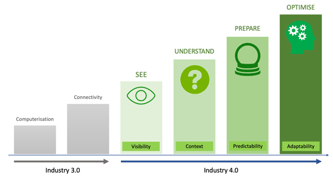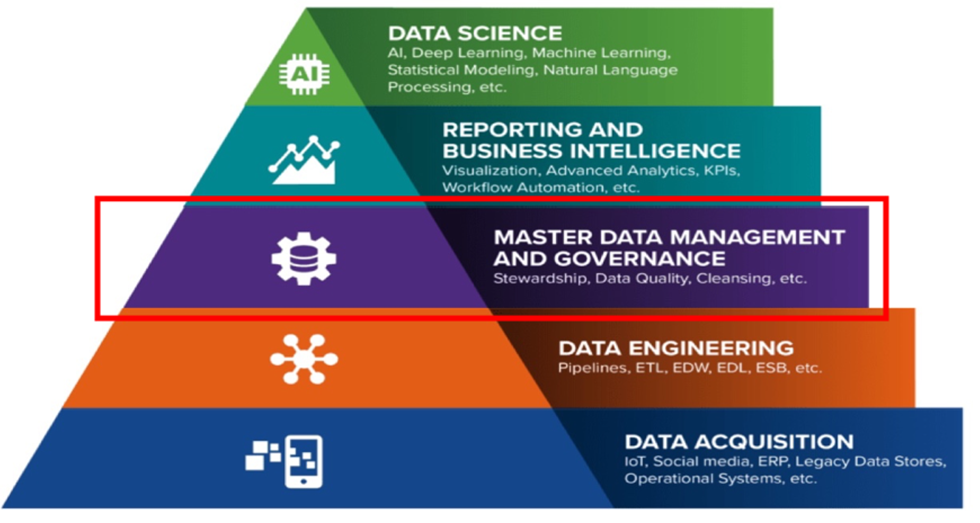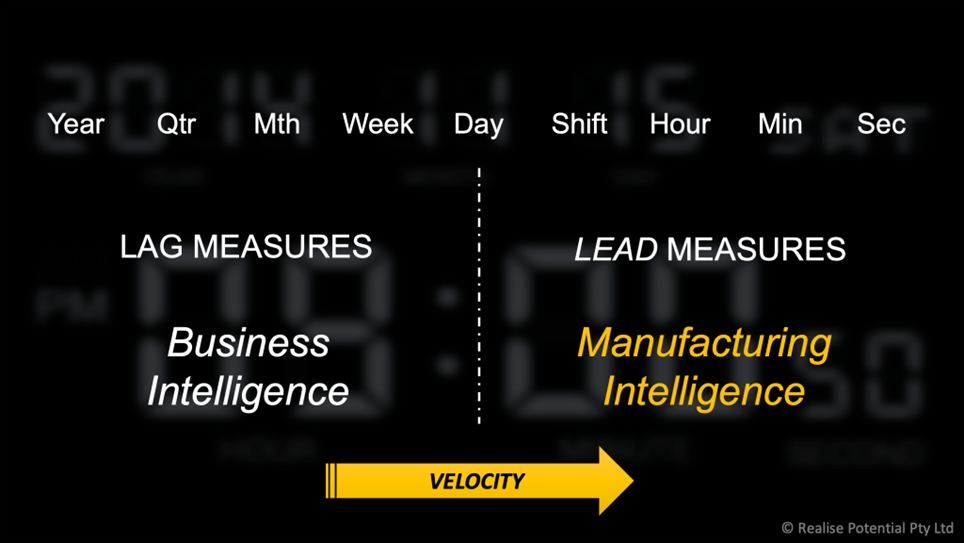Who Holds the Keys?
I came across a fascinating article that showed a pyramid hierarchy and how data flows up through various levels of an organisation. Before I share it, though, I wanted to take you through a well-publicised, Industry 4.0 maturity journey first, as I've realised the two are closely related.
Welcome to the final episode of a fourteen-part series by John Broadbent from Realise Potential.
Let's start with the Industry 4.0 maturity path.
Once on the Industry 4.0 journey, we know that there are generally four levels of maturity, and like any journey, you can't start at the destination. However, some fail to acknowledge this and then wonder why projects in this space have a high failure rate.
The four levels can really only kick in when we get our Industry 3.0 house in order, and if you've seen Episode 5, it's not rocket science.
You may remember that computerisation and connectivity are the foundation steps from Industry 3.0 that must be in place prior to commencing your Industry 4.0 journey.
 This graphic shows them in grey. Once we start to mine and collect information from our plant-level systems, we're now able to SEE what's going on in our manufacturing environment. In other words, we can now have real-time visibility into what's going on. This is a bit like having a speedo in your car. It tells us how fast we're going, but that's all.
This graphic shows them in grey. Once we start to mine and collect information from our plant-level systems, we're now able to SEE what's going on in our manufacturing environment. In other words, we can now have real-time visibility into what's going on. This is a bit like having a speedo in your car. It tells us how fast we're going, but that's all.
As we mature, we can now contextualise the information we're seeing. While our speedo tells us we're doing 80 km/hr, the speed advisory sign of 60 km/hr gives us a frame of reference. So now we have the context to realise we're hit breaking the speed limit and might get a ticket. Context allows us to UNDERSTAND, so it's imperative we deliver the right information to the right people at the right time and in the way they need to consume it.
As we further mature, we can learn from the past to prepare for what might happen next. For example, a simple real-time SPC chart might show we've had multiple values heading north towards that upper control limit, and the last time this happened, we made an out-of-spec product. This leads to the opportunity for predictability.
Finally, as we further mature, we can make changes to processes to avoid predictable situations. Such as adjusting process values to avoid making waste. For example, we can optimise upstream or downstream process conditions to be ADAPTIVE.
So how does all this relate to the data pyramid I mentioned earlier?
Let's take a look at the various layers of the pyramid and their function

The first layer is all about acquiring the data, that is, connecting and extracting, hence, why the connectivity and computerisation pieces are precursor steps. If we can't get to the data, we can't move any further up the pyramid. This is the SEEING level of maturity mentioned earlier.
The second layer then becomes about CONTEXT, which is transforming data into usable information for delivery or consumption at various levels of the organisation. This typically requires some type of transformation and an application to mash up data from multiple and often disparate sources into meaningful information. This is the second level of maturity or understanding, as we encountered earlier.
The third level is an interesting one and one that I found distinctly lacking in a large majority of manufacturers, hence, in my view, a significant roadblock to maturing along the Industry four path. This is the level of stewardship, that is, taking care of data collection itself and transforming and delivering real-time information.
If you've had any experience with ERP systems, for example, you'll know full well that you can't just go and put or change information in a production environment. You have to pass through various gates and often the large ERPs have DEV, TEST and PROD environments, where changes are developed and tested before they go into production.
In ERP parlance, each step is called a transport, that is, ensuring appropriate sign-offs and system checks have been done before a change can be transported into the ERP's production environment. Of course, it's great to have the luxury of multiple environments to test and transport, so it can be difficult explaining to IT people that such a process isn't really applicable to automation since we don't have DEV and TEST factories!
We can, however, do much with simulation and pre-testing and this is how many changes are implemented. But talk to any automation engineer, and they'll all tell you commissioning code on a running plant is living on the edge and can be very, very stressful.
What's this got to do with level three in the pyramid?
Well, ERP system owners often have a master data team to ensure the transport process is followed and the data being put into the ERP is valid in the first place.
But I'm yet to find a manufacturer who has such a team for their automation stack, although I do know some big end-of-town global players have centralised teams to manage this, especially since these systems are often mission-critical. Most, however, let external contractors or internal resources make changes and hope for the best.
I often find there's no steward for the entire automation stack, whose job it is to ensure data is being correctly collected, cleansed, appropriately stored, and delivered. It's a governance role and a vital one at that. It ensures the right things are being collected at the right time and delivered in the right way to the right audience, which brings us to the fourth level of the pyramid, MI/BI, or what I call manufacturing intelligence and business intelligence.
To clarify, I define manufacturing intelligence as the real to near real-time world of manufacturing, so you can think of it this way: If we split our time domain into year, quarter, month, week, day, shift, hour, minute, and second, I found that the day' time bucket' is a rough line of demarcation between these two worlds.

On the left, we have the realm of LAG measures and business intelligence, and on the right side, we have lead measures in the realm of manufacturing intelligence.
Often the tools used to capture, store, and report in the BI world (think of data cubes, Power BI, Tableau, QlikSense, Cognos, etc) are very different to the ones used to create real-time performance dashboards.
BI reporting tends to be more settled and stable too. In that, for example, once a cash-flow or budget report is created, it tends to be fairly static in its design.
Manufacturing intelligence dashboards, on the other hand, tend to be more dynamic, and because of this, mashup tools such as ThingWorx, MindSphere, Microsoft IoT, Aveva and others exist to help those building dashboards be more agile with their development.
Finally, we get to the top of the pyramid, which is the home of machine learning and artificial intelligence, also known as ML and AI, the place where you'll find the need for data scientists.
If you want to mature as a manufacturing business and explore this role at some point in the future, you must have some knowledge of the layers below and some systems in place to support them. Ironically, if we look at a value pyramid it's actually inverted since the value of raw data at the bottom is low, while the value found in machine learning insights at the top, for example, can be extraordinarily high.
No matter where you are on your Industry 4.0 journey, stewardship is a key aspect and as I mentioned earlier, one I see lacking in many manufacturing businesses. I know from my and others' experience that the "She'll be right mate!" attitude to the collection of manufacturing data and what to do with it simply doesn't work at scale. It's fraught with issues and often creates problems further up the data consumption pyramid.
Stewardship is a key role, especially as we're relying more and more on data collection from our manufacturing processes.
My recommendation is to take a look at your business and the manufacturing systems themselves. Think PLCs, HMI, SCADA, MES Databases, historians, etc and ask, "How might my business embrace stewardship and who might that person be?"
Be careful too that you don't give the fox the keys to the hen house, and by that, I mean automation engineers might not be the best people for the stewardship job itself, since, as an ex-automation engineer myself, sometimes our zealousness for information can blind us to the effectiveness of what it is we're collecting.
Data for data's sake is not a strategy nor good stewardship.
As always, if you need any help sorting through this or other Industry 4.0 or Smart Factory-related issues, you can reach out to me on LinkedIn or via the Realised Potential website.
John Broadbent

Watch John's original LinkedIn video here.
.png?width=190&name=IPA%20Logo%20Transparent%20(Hi-Res).png)




